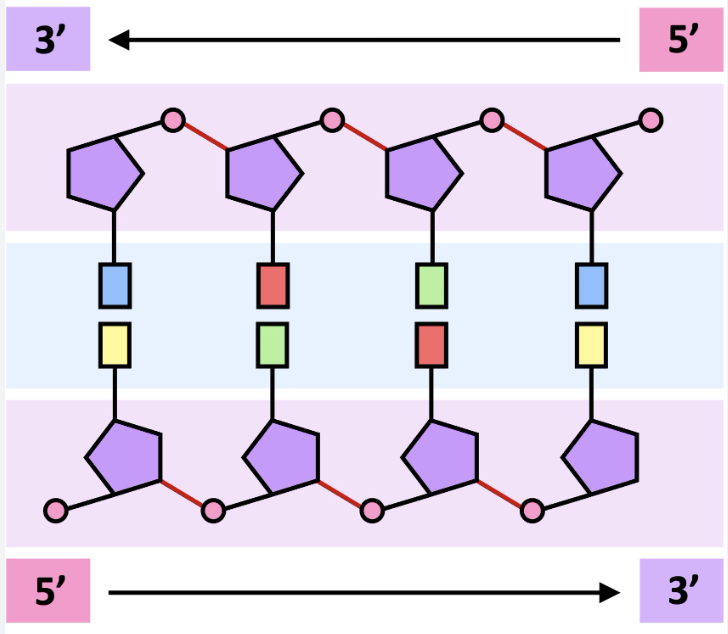Bio Module 5 - topic 2 (cell rpelication)
1/31
Earn XP
Description and Tags
mitosis + meiosis on other ards
Name | Mastery | Learn | Test | Matching | Spaced |
|---|
No study sessions yet.
32 Terms
structure of DNA
long double stranded helix
sugar phosphate backbone attatches to nitrogenous bases that bond in specific pairs
function of DNA
carries all genetic information coding for protein production - enabling cell growth repair and other specialised functions
nitrogenous bases in DNA and how they bond
Adenine and Thymine join by double H-bonds
Cytosine and Guanine has triple H-bonds
how are elements of DNA bonded together
phosphates are attatched to deoxyribose sugars by covalent bonds, strands (bases) joined by H-bonds
what is a nucleotide
each consists of sugar bonded to phosphate joined to nitrogenous base
5’ end of DNA strand
the ‘front’, has phosphate group on the end

3’ end of DNA strand
the ‘bottom’, has hydroxyl on end (from sugar)
what is a gene
it is a sequence of DNA that contains a particular sequence of nitrogenous bases that have specific role of making info for a type of protein
chromosome
DNA wound around histone proteins that is coiled over and
composition of DNA
composed of chromatin which are fibres that contains:
40% DNA
60% protein
female 23rd chromosome
XX
male 23rd chromosome
XY
‘homologous chromosome pair
chromosome pair that are similar in shape and size and contain same genes in same order
one is from paternal and one is from maternal
how do chromosomes change throughout cell cycle
G1 phase: 1 chromatid + one chromosome
G2 phase: 2 sister (identical) chromatids
After mitosis (M phase): 2 identical chromosomes
how many DNA molecules in a chromatid
1 long molecule of DNA
when does DNA replication occur
in S phase
steps of DNA replication
helicase enzymes unwinds DNA strands
primase enzyme makes small piece of RNA - creating a ‘primer’
DNA polymerase enzyme binds to primer adding free nucleotide units to it complementary base partner
However, polymerase can only add bases continuously in one direction (from 5’ to 3’ end) - and hence only continuously add bases on the leading strand of the DNA
So in lagging strand: polymerase adds in sections → ‘okazaki fragments’
Once DNA has been made, exonuclease enzyme removes RNA primer, so that another DNA polymerase can fill gaps with bases
Replication errors are identified and corrected + ligase enzyme seals up fragments of DNA in both strands
what enzyme checks over replication errors and how
DNA polymerase corrects base pair errors by splicing out incorrect base + replacing w/ correct base
what do incorrect base pairs cause?
mutations
what happens if damage to DNA is not repaired
cell undergoes apoptis - programmed cell death
diff between somatic and germline mutations
somatic is in body cells, germline in gametes
somatic only affect individual, germline in heritable
what is mutation, what is its effect?
it is simply a change in DNA, it can be benfifical, harmful or ineffective
what does genetic continuity rely on
Consistent replication of genetic info passed from parent to daughter cells
The effect of natural selection + evolution on the gene pool as a result of - more advantageous gene combinations are more likely to survive
Introduction of variation during sexual reproduction (in meiosis)
random errors arising by mutation, being replicated and passed onto offspring (new allele formation)
Random variation that produce an advantage may be selected over those that cause no advantage/harm
what are 2 types of genetic errors
spontaneous mutation
mutagenetic mutations —> from environmental factors e.g celll exposure to radiation + chemicals
diff between prokaryotic and eukaryotic DNA
Prokaryotic
singular, circular chromosome in cytoplasm
is not tightly coiled around histone proteins
has only one copy of each gene
very little non-coding DNA
Eukaryotic:
discrete, linear molecule in X shape located in cell membrane nucleus
DNA is tightly wound around histone proteins
multiple copies of genes
large sections of noncoding DNA
—→ also mitochondria and chloroplasts in eukaryotic organisms possess their own DNA (non-nuclear DNA)
phenotype definition
the observable physical or biochemical characteristics of an individual organism, determined by both genetic makeup and environmental influences
factors that affect phenotypic expression
Genotype - is inherited
Environment - not inherited
epigenetics
studies how chemicals can change the way genes in DNA are expressed → aka why environment can affect our phenotypes
how - according to epigenetics - can environment cause genes to be expressed
relaionship between phenotype and genotype
The genotype of an organism describes the specific alleles for a particular gene, and the phenotype describes the appearance of the organism associated with the genotype
How can environment effect phenotype
environment can decrease/stimulate the expression of the genotype therefore changing allele
example of how environment can effect phenotype
A person’s height is determined not only by genes inherited but also nutrition
A person’s skin colour is determined by amount of melanin produced but also genes can also be stimulated to produce more melanin in response to UV rays
Hydrangeas will create blue or pink flowers, depending upon soil’s pH